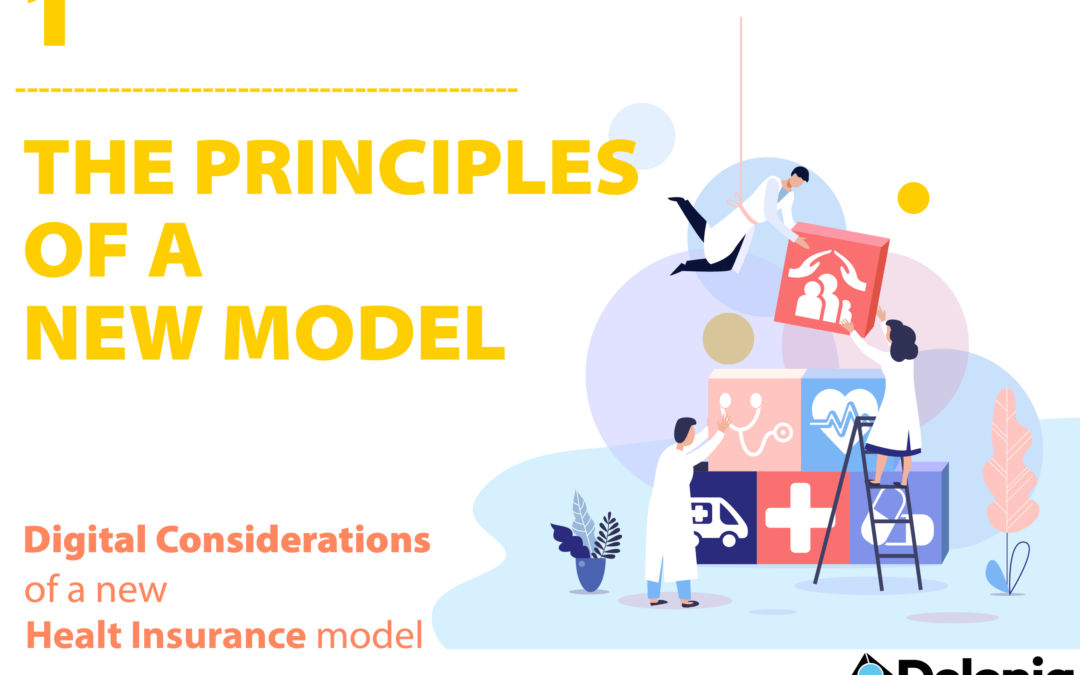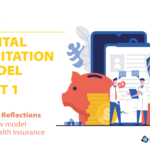Describing in a simple and comprehensible way a new insurance business model in the health insurance sector, as an alternative to the current model, goes beyond technology and software development, although digitalization plays a key role in it. This is the aim of the series of articles we are starting, to define a model adapted to the needs of the customer and patient of the future, but who already demands a different service from their health care providers.
The description of this model will be shown through User Experiences that will indicate the functionalities of the model and how the different systems/modules involved are articulated and linked. We will develop this content in each of the chapters of this series of posts, but as a preamble it is necessary to emphasize the principles or foundations on which this transformational model is based. Although we are not going to analyze at this point the change in business culture on which the transformation must be based, we must insist that people are the basis of any digital transformation process.
The description of this model will be shown through User Experiences that will indicate the functionalities of the model and how the different systems/modules involved are articulated and linked
The principles on which this model is based are summarized in the following points:
1. The new role of insurance companies.
Much of the poor image, or at least the low recognition, of health insurers is due to the role they play in the process of managing the health of their policyholders. The health insurer’s role seems to be reserved for inquiring about health questionnaires, collecting premiums and co-payments, “administrative hurdles” with cumbersome authorization processes, and paying bills. The end user, customer or patient does not appreciate that their company contributes to improving their health; on the contrary, it seems to put obstacles in their way.
For the company, truly caring about the health of the insured and transmitting this concern to them seems to be a clear strategic objective and a decisive pillar for attracting new clients,apart from the scarcely credible and conventional marketing campaigns. It is necessary to move from a merely administrative role oriented towards managing the benefits of treatments and procedures, towards a function oriented to the patient and the best way to treat their illness. In other words, we must focus on the pathology of our clients, and when talking about pathologies, we must consider the past (history), the present (current treatments) and future (preventive medicine). The focus of all businesses is the customer, but in the context of health we must keep in mind that the customer demands attention for his medical issues and ailments. That is why pathology is a key issue.
How is it possible that a customer of a company, after years of paying for and using his policy, does not have, in a natural, simple, and accessible way, a medical history of his past pathologies? How is it possible that the company does not know what pathologies he is currently suffering from, despite covering them? How is it possible that, “knowing” the customer, it does not anticipate the best ways of dealing with possible future problems?
The insurance company will not be responsible for the treatment of pathologies; that is what medical professionals are for. The aim is to facilitate, convey and guide the customer on the best means available in the company, through its medical repository, and to respond to their health needs through a Personal Health Assistant, which may be a human and/or software based on a knowledge graph and artificial intelligence techniques. From this approach, the role of the insurance company changes completely by putting the focus really on service and supporting its work in the management of diagnoses and personal assistants.
We have to focus on the pathology of our clients, and when we talk about pathologies, we have to take into account the past (history), the present (current treatments) and future (preventive medicine).

2. Iteractivity. On-line health. Mobility. Accessibility.
One of the most relevant and specific characteristics of health insurance operations and logistics is ITERACTIVITY, which makes it significantly different from other branches in the insurance world. . Interactivity can be understood as the number of contacts/tasks that a customer makes with the company in a given period (it could also be defined as the number of interactions of a customer or how many times he/she interacts).
Health insurers often use the frequency ratio , the number of medical services (acts) that a policyholder performs or consumes in a period, but this ratio does not reflect the number of contacts/procedures that a client makes with the company. For example, a covered medical service, such as a gynecological consultation or test, counts for the frequency ratio as “one”, but to be performed it is possible that the client may have to make the following steps:
1.Seek information about your health problem (on the company’s website or other channels outside the company).
2. Consult the company’s medical directory to find professionals who are suitable for your condition.
3. Once with the chosen professional/center make an appointment (usually by telephone) and probably after trying to contact them several times.
4. Ask the company for authorization if the service requires it, of which you will probably only have been informed by the medical professional when making your appointment.
5. Finally, attend the appointment and receive results, which may require a new appointment.
Ideally, to facilitate all these tasks, it is necessary to have a system that can provide them and deliver them to the customer/user in the palm of the hand (app/web). This would be the way to significantly improve the current experience, which the insured perceives as rigid and uncomfortable.
All these activities require a digital model to support them at any time or place. The intensity and prevalence of use by the customer is much higher than in any other insurance, which justifies the company providing online systems, web, app, accessibility, and mobility. For example, it seems clear that downloading a mobile app for health insurance management is more justifiable than for a life insurance policy that, in the worst case, will be used only once.
One of the most relevant and determining characteristics of health operations and logistics is the ITERACTIVITY, which makes it significantly different from other branches in the insurance world

3. Unified Personal Health Record. Integration of clinical information.
A record of each person’s clinical information seems to be a priority objective, both in the public and private systems. In the software market there are countless solutions for the personal medical record, but they all suffer from the same problem, leaving the responsibility for uploading the clinical information to the user and sometimes in a way that is neither simple nor intuitive. Nor do they provide for easy downloading of the information, so that it is truly useful for professionals.
The proposed solution is to create a unified personal health record for clients/insured and providers. This repository must comply with and be designed according to the following principles:
1. Automatic uploading of information from the services provided by the professionals. This will be done from the professional’s PA (Private Area) or by means of web services (Api).
2. Control and management of strict access permissions authorized by the client. The client decides who sees what, for what purpose and for what by means of their health PIN.
3. Possibility of downloading reports to those professionals who decide to do so and are duly authorized. These reports must be included in the Clinical History that each professional has of their patients.
4. Identification of the diagnoses affecting the patient.
5. Possibility of migration of information. Export/Import.
Although misgivings are always present when talking about personal health data, we should not forget that the legal and data protection requirements for a functional and meaningful patient record are within the reach of any insurer.
In the software market there are countless solutions for the personal health record but they all suffer from the same problem, leaving the responsibility of uploading the clinical information to the user and sometimes in a way that is neither simple nor intuitive
4. General Prescription Repository.
Repositories must be built and implemented for all types of prescriptions, similar in philosophy to those of private electronic prescriptions approved by the General Councils of Official Prescribers’ Associations.
These prescriptions, for example for analysis, tests, or treatments, will be accessible to:
1. The insurer, which may advance and expedite the authorization of the services that require it. This authorization may be managed through an automatic verification and communication mechanism or be derived from manual processing.
2. Healthcare professionals, who will be able to set up appointments for their patients online and carry out the service without having to manually verify the authorization of the appointment.
This practice would improve the authorization process, freeing users from this unbearable procedure and radically changing their user experience.
A general repository of prescriptions would free users from this unwieldy procedure and radically change their user experience

5. Health Assistants.
There is an obvious need to help and assist users on health-related problems that concern or may concern them, not only in clinical matters but also in purely bureaucratic aspects.
In this regard, they should be provided with accurate, reliable, and orderly information on:
1. Symptoms/Pathologies/Treatments: What they are and related content. Guidance on what can happen and how to proceed. Knowledge graphs and the semantic web will be key elements in this process.
Doctors and Centers: Who are they and what are their references, what are they really specialists in according to pathologies and treatments. Gathering information on a detailed medical repository with related content is a current lack in all healthcare models.
3. Access to services: Facilitating how to access services provided by a company, online appointments, authorizations, procedures, and relevant service information.
All these facets require an intelligent assistant that responds to these needs and doubts. Dicho asistente, que podrá ser desde un chatbot, This assistant, which may be a chatbot, virtual assistant or any natural language processor (written or spoken), needs a knowledge graph that supports these enquiries or searches by the user. All this without forgetting the environment and context of the user’s search, which may be anonymous (with queries from the public area) or personalized from a private area with information specific to the case.
All these facets call for an intelligent assistant to respond to these needs and doubts
6. New relationship between Professionals and Insurer.
The current model, based on payment of professionals on a fee-per-doctor basis, seems to be outdated and exhausted. The relationship between the two parties must improve and progress towards a partnership that provides greater added value. This would imply an increase in the quality of patient care and an improvement in the economic conditions and benefits for the professional. All this in a context in which serious consideration is given to how to modulate these improvements and pass them on to the insurance premium appropriately.
A new relationship model must be based on:
1. Improvement of the level of information on providers and providers (improved medical directory), detailing their CVs, subspecialties, techniques, specific treatments and, if possible, information on their activity. A complete fact sheet on the services of doctors and centers that can be presented to patients.
2. On-line service relations for: On-line appointment, information on medical acts (pathology in progress), prescriptions, authorizations and invoicing that minimizes conciliation conflict. Promote payment by processes (including consultations) and capitation versus payment per medical act.
3. Promotion of the service portfolios of the centers and professionals, regardless of whether the service is insured or not.
4. Promotion of video-consultation for all specialties, especially for post-treatment follow-up processes. All professionals should be able to provide a video-consultation to their patients.
The current model based on payment of professionals on a fee-per-doctor basis seems to be outdated and exhausted. The relationship between the two parties must improve and progress towards a partnership that provides greater added value.
In successive posts we will address and describe all these issues in more detail, especially from a functional and operational point of view. More focused on the development of the necessary tools and skills and not so much on the policies or strategies that their implementation would imply. But we cannot forget that a change strategy towards digitalization can only be successful from the complete alignment of the company that promotes it.






